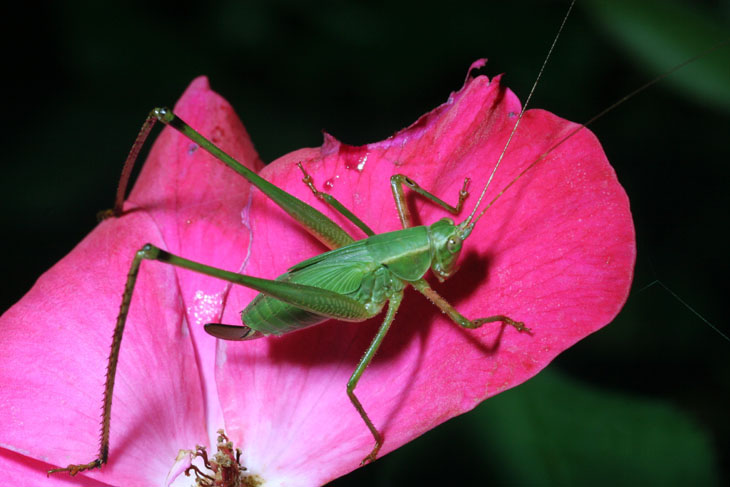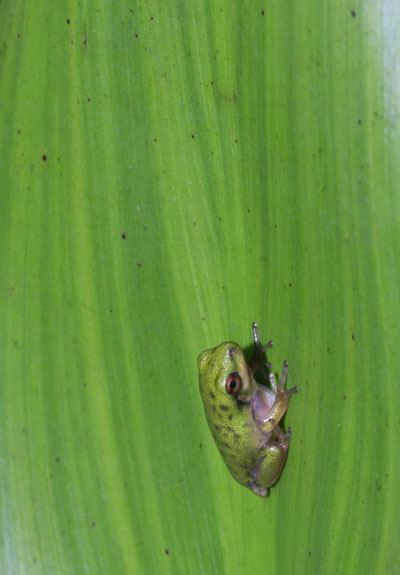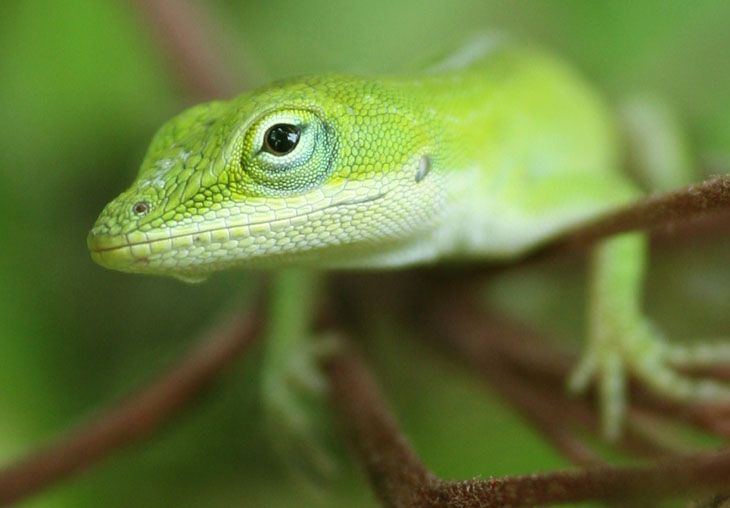I’m not surprising anyone when I say humans are a social species, both from the biological definition and from our own self-description. But it goes further than that – we’re socially-influenced and socially-dependent, meaning we make a really stunning number of our decisions based on how we feel others will respond to them, often without any other consideration at all. This isn’t just about fads and fashions and middle-school students either – status is only about the perception of others, and that extends up to what cars we drive and what houses we buy. Think about that for a second: we will make our decisions about the expenditure of thousands, even hundreds of thousands of dollars based on what someone else thinks. Certainly, not entirely (and yet, are we sure that applies to everyone?) but when it comes down to it, the practical considerations of what functions best, what is most efficient, what fits our budget best, and so on, all somehow compete against the opinions of others, as if this had some importance, some impact, some necessity. We might spend years in education and training, then gaining experience, working our way up the ladder, largely to maintain and especially increase our status. It’s almost frightening.
That this is actually an evolved trait leaves little room for argument, especially since it’s existed in our species for all of recorded history (and all of the fables as well,) prevalent throughout the world in every culture. And why it evolved into us makes sense too, when we consider our past. For millions of years, our ancestors lived in small groups or tribes, hunter-gatherers, struggling for survival against countless factors from scarce food to bad weather to literal hominid-eating predators. Like many other species, it was better to have a cooperative social group than to try and exist as individuals, reaping the advantages of pack-hunting and community child care and larger-scale farming and the safety of numbers. But to maintain a cohesive group, there must be the instinct, the desire to cooperate and interact. We tend to believe that most everything we do is the result of rational consideration, the careful weighing of benefits – that’s what our brains are for, and what ‘sets us apart from the animals’ (always an amusing phrase – what are we, minerals?) But plenty of other species, from elephants to ants, also operate on the same principles, and it’s safe to say they’re not all getting there because they sat down and weighed the pros and cons. There’s little if any reason to believe that we don’t possess the same kind of evolved behavioral instincts, and quite a few to believe that we do.
For some species, it may amount to almost programming; ants may have just a handful of near-automatic behaviors – construct the community warren, raise the young, protect the queen, and so on. As the environment presents more challenges and variables, however, it becomes harder for brains to have defined answers for everything, and easier to have them capable of evaluating a situation when it’s encountered; decision-making. The weather is turning bad – seek shelter or ignore it? And right away, we can ask ourselves, well, how bad is it? (I’m sorry, I don’t have a punchline to follow through with, but if you have a favorite, feel free.) And we, and other species as well, look through past experience, and consider time lost while sheltering, and above all we think, how important is it to keep foraging? Because survival is the pattern that natural selection produces. The individual that has the tendency, the desire, the prod, to behave in a manner that’s slightly more useful, that increases the chances of surviving to reproduction, is the one that spreads its genes more effectively.
Cooperation is the same way. The group, the tribe, the village – they have to stay together, not just physically, but on goals and ideals as well. What we got out of the selection lottery is the reliance on the opinions of others, the desire to appease our group (what we might call peers now, but in the past it was our extended family or tribe.) Without this, getting kicked out of the tribe because we weren’t interested in the same goals would be a fairly common occurrence, and without another group of people to hunt/forage/huddle with, we could die easily. And, very likely, did – ending any genetic behavior towards individualism.
This necessity existed for millions of years – in the history of life on this planet, it was only recently that we no longer needed this trait so much. Just in the past few thousand years, even few hundred, have we gotten to the point where survival wasn’t nearly as dependent on others – that’s an eyeblink in terms of genetic change. Evolution has this property where it shapes the species towards the environment, but the environment can change rapidly, and at any given time the species may be in the process of catching up – and those that don’t, go extinct. But it means that an unknown number of traits, perhaps quite a lot, are for conditions that were, but no longer are.
More interesting, however, is how this is accomplished. We have the desire to care for and protect babies, which is good, because damn our young are worthless for years. But it’s remarkably unspecific, so unspecific that we can fawn over, uh, fawns – research has shown that we respond to factors such as heads out of proportion to bodies, eyes out of proportion to faces, short limbs, and so on. Yes, everything that women think is ‘cute’ about baby anythings – you’re getting the picture. The funny thing about natural selection is that it doesn’t have to be specific to work, and a false-positive may be absorbed as long as it isn’t detrimental, or at least, significantly detrimental. If the benefits outweigh the detriments, there’s the advantage that can be selected.
Cooperation is a little more complicated. First, there’s the concept of who deserves the cooperation. Again, selection works on the genetic level, so what’s going to come out of that is what gives benefit to those who are related, that can carry the same genes. From the standpoint that a sibling has the greatest percentage of the same genes, and a first-cousin a lesser percentage, and a distant cousin even fewer, behavior that favors the immediate family tends to be strongest. A tribe in prehistoric times has been surmised to have usually been made up of an extended family unit, and in areas of the world where such cultures still exist, this holds true; thus, the tribe typically was the family, having a much higher chance of carrying the same genes as any other tribe. Even if it absorbed an ‘outsider,’ said absorbee would likely marry a relative anyway. Yet the selection of ‘peers’ is trickier, since tribes might merge into stockades or villages, or even temporarily join for harvest or hunting benefits, so what seems to have been selected was a tendency to bond with ‘like-minded’ individuals, those that shared the same interests, outlooks, goals, et cetera. If this sounds like internet chat groups, well, there’s a good reason for that. It also means that this distinction of ‘in-group’ can be variable, depending on the situation, allowing allegiances to change to fit the environmental demand.
And for every in-group, there’s an out-group, the reason such a distinction is even made. From the natural selection standpoint, this is a group that has little to no likelihood of sharing genes or beneficial traits. The gene part isn’t always something readily apparent, but the beneficial trait part is covered by seeking like-minded companions. Those that show radical differences earned the mental classification of ‘out-group,’ perhaps not necessarily ‘enemy,’ but certainly not those to associate with. Strong bonding and reliance revolved around the tribal unit, strengthening the unit itself, while an almost disdainful attitude towards outsiders kept us from watering down the genetic legacy, and whatever benefits it might contain.
Today, our tribalism exists in countless forms. Consider how we select ‘our’ sports teams – yes, the possessive is always present, and very telling – on the basis that they exist in the same school, or a nearby city, or the same state; nothing whatsoever to do with how good they might be, or even the utter idiocy of merely watching, rooting for, getting ridiculously emotional over, a fucking game. Seriously, how does this impact our lives? We remain concerned over how we dress, such as still giving great emphasis to suit jackets and ties, never considering the pointlessness of either one, the peculiar tailoring required, and the idea that as functional clothes they accomplish almost nothing that clothes are supposed to, too hot in summer, not warm enough in winter, and so worthless for protection that we have to be careful not to damage them. We’re playing dress-up for everyone else, without a moment’s thought. We have countless social conventions, like saying, “Bless you” when someone sneezes and not farting in public, as if these weren’t mindlessly trivial. We make up every word that we speak, and have to agree as a culture on what they mean, but then we react in horror if we actually say some of them. We avoid admitting to the music we really like, because it’s not popular. [Duran Duran, the early years, fuck you.] We spend large portions of our lives almost terrified that we might gain some form of disapproval from others, to the point where we’re uncomfortable, conflicted, spending too much money, and who knows how many other inconveniences. And we like to believe that we’re a thinking, rational species. Please.
It gets worse. The peculiar behaviors of mass hysteria and mob mentality (links one, two, three, four, five) are well-studied and disturbingly common, and they can often result in people dying. I want to note that a couple of those links give the Salem Witch Trials as an example, but Salem’s panic lasted fifteen months while the European witch hysteria lasted three centuries. And yet, it isn’t even the distinctive events that deserve the attention, because there are two (at least) much bigger and more prevalent examples of social influence that result in horrific behavior, and those are religion and nationalism.
We’ll start with nationalism, which is largely the same tribalism as that sports nonsense above, expanded to the imaginary demarcations of a country. It takes no effort to find an online forum where nationalism springs up in an ugly manner, often sparked by the observation of some form of silly behavior (as well as a broad stereotype, and I’ll let you ponder the source of those.) When France refused to support the US invasion of Iraq a little over a decade ago, this country got so childishly fervent that we started using the term, “freedom fries,” as if invading another country personified freedom in any way, much less any recognition that France had the freedom to disagree if they desired, which is what the word means. Countless antagonisms the world over have their basis in some event that occurred decades to centuries ago, that has no possible impact on anyone today; they remain important, even dire, because everyone else finds them that way. In the intervening time, the leadership might have changed in both person and function, the economic structure undergone radical fluctuations and even collapses, the allies and trade centers bounced around, perhaps even the languages changed – but that Great Injustice of So Long Ago? That remains preeminent. Remember the Alamo…
I want to touch briefly on some observations about Nazi Germany. While Hitler is now practically a curse word, the man himself most certainly did not act alone, nor can we even narrow things down to the Nazi high command – it took a large percentage of people to go along, and always does, or leaders would have no power whatsoever. While the bulk of the military, much less the public, were kept unaware of the practices within the concentration camps, they were still well-staffed, and enough purges took place outside of them as well – purges more often than not upon the same countrymen. There is a tendency to think in terms of “Nazis” or even “Germans,” but this kind of behavior can take place anywhere, among anyone – less than a decade after the war trials, this country was swept up into the ‘Red Scare’ and McCarthyism, and still demonstrates mindless group-think such as worrying about birth certificates and the immigrant ‘invasion.’ Ironically, we end up using these tribalism traits to try and distinguish that such traits are only practiced by other tribes…
Now let’s pick on religion again, because it’d be a shame to write this many words and not piss someone off. Religion, despite the evolved behavior that seems likely to foster it, wouldn’t even exist without the cultural emphasis and social influence. There are too many different religions to believe any one of them can demonstrate its value, accuracy, or divine provenance. And this is if the vast majority of the faithful even had any knowledge of other religions beyond their title; most people practice the faith that they grew up in. There are literally countless sects, variations, denominations, practices, and delineations, so many that it’s more accurate to consider each individual place of worship as its own religion than to think that, for instance, all muslims believe the same thing. The rampant selectivity over not just the practices, but the weight given to various portions of scripture (the supposed word of god) shows that it isn’t even the veneration of supernatural influences that deserves any credit; much the same can be said for the rather imaginative interpretations given to said scripture, based on no scholarly method or translations, that somehow form the backbone of so many practices. I sit here in a state that has outlawed same-sex marriage, yet considers shellfish like shrimp (another very distinctive sin, according to the same scripture) not just a food staple, but a major economic foundation. I don’t know if anyone has actually done any surveys, but I’m personally willing to bet that at least half of the self-professed devout don’t even know the passage about shellfish exists; they’re not familiar with their scriptural sources, much less seeking guidance from such – they just listen to what’s handed out in church.
And yet, the religious influence the world over is astounding, another manifestation of tribalism that results in a truly loathsome amount of bloodshed – not from being able to demonstrate even accuracy, though benefit would be a much better goal, not to protect themselves, not even for justice, but because there’s simply this underlying attitude of, “us right, you wrong.” Often, wrong goes so far as to mean subhuman, non-chosen, demonic, possessed, and so on. And while I’m more than okay with examining the real motivations behind religious conflict (any conflict,) we have to still recognize that what works to fire up the populace, the reason why religion keeps appearing in the midst of conflict in the first place, is the social influence that it’s important. None of the benefits ever quoted for religion can be used to justify slaughter, and most adherents even try to downplay the scriptural passages where it takes place, knowing that it’s not a viable method of improvement. But it doesn’t take a whole lot to start the fire going, either, just like it doesn’t take much for riots to occur.
While the violence is more than enough to justify grave doubts, it’s far from the only detrimental practice fostered by religion. The US sees constant attempts to censor, dismiss, and even legislate against good, solid science, the kind that’s proven its value over and over again. The vast bulk of legal action to protect both civil liberties and Constitutional rights takes place because of religiously-motivated campaigns. A stunning number of people believe, without any evidence to support it (and a fucking hell of a lot that contradicts it,) that religion is responsible for morality, which naturally leads to the bizarre idea that doing anything in the name of religion is good. More times than not, when someone is getting seriously uptight about something, you’ll find religion beating the drum (and they say atheists are angry.) Pay attention to any marginalized or discriminated group, anywhere, and see how often the justification is religious. It’s honestly pathetic.
I will clarify here that I do not believe that this social influence is the sole provocation for either nationalism or religion, nor even the sole negative influence. And indeed, there are a handful of good, rational reasons to hold some of these attitudes. The overall agreement on the values and goals of a country provides the cohesiveness to see that these are maintained – but that’s hardly what we see in this country, where the fractions of political parties are at each others’ throats not over any agreement or disagreement about direction, but simply because those other parties are the enemy; whatever excuse that can be found to justify and reinforce this is seized upon without reservation or honest consideration. And religion also owes a lot to privilege, righteousness, and insecurity. Yet, take note of all of the negative influences and aspects of any form of behavior, and see how often critical examination and careful decision-making is the culprit.
That highlights the part that might be amusing, if it wasn’t for all the utter shit that ensues: it’s all just an urge. The social drive is weaker than our sex drive, easier to ignore than having to urinate. It’s this little finger on the scales when we’re weighing options, able to be pushed off, but only when we’re aware that it occurs. The problem lies entirely with our tendency to react, to make decisions based on immediate feelings rather than any form of rational consideration – and worse, to justify such reactions afterward. Anyone may claim that their circle of social media ‘friends’ is a form of networking, or helps them keep in touch – but do we really believe that, or is it just another method to seek a nonsensical status? Should we even care what strangers think? Does this have any effect on our lives, one way or another? Hell, even if someone thinks you’re a total boor in the grocery store because you didn’t say, “Bless you,” when they sneezed, are you ever going to encounter them again? And should you care that they’re judging you on the most superficial of standards? Don’t bother bringing up the word respect because that’s not at all what it means, or should mean. But certainly, when it comes to money, or the time and effort we’re expending, does popular opinion have any reason to be a factor at all?
If it helps, realize that, in any crowd of people, fully half of them are below average intelligence – some of them are downright idiots (and their popularity is hardly a guide in that respect.) Or it might help to know that a lot of people have already tumbled to this trait in humans, and are exploiting it in numerous ways. Do we really need to see a counter of how many people liked a video to know if we should like it or not? How many times have we heard the argument that “millions of people can’t be wrong”? Merchandisers prey on the tendency for people to find something popular, because that’s their cue to jack the prices. Not to mention that our political system is nothing but a popularity contest because voters can’t be bothered to concentrate on the ability to govern…
By no means should this be taken to espouse an anti-social attitude – we’re still a social, cooperative species, relying on group efforts for food, roads, medical care, and so on. And there’s nothing that will deny or replace our desires for social interaction – nor is there any reason to, since this aspect doesn’t create much in the way of problems for us. It’s only when it goes overboard, influencing or outright replacing the decisions that should be made with consideration that it becomes problematic; but this happens a lot. We’re also limited in how much we can do about it, in many ways. We might skip the suit-&-tie for a job interview, only to run afoul of that expectation from the potential employer, who still believes that it makes some difference (or that there is such a thing as professional-looking, like someone’s appearance will define how well they work.) Yet, overall, placing emphasis on making sense, on providing good reasons for doing anything, and most especially, on not doing something because we’re expected to, or everyone else is doing it, is going to help us in the long run. The wonderfully nuanced brains that we possess are also an evolved trait, capable of fathoming how atoms interact and measuring light, giving us the ability to make quite specific decisions in the face of countless variables – it’s a shame to let them be hobbled by a kneejerk reaction, an influence that lags behind our progress as a species. At least getting emotional over baby animals doesn’t end up killing anyone.
What’s funny is, sometimes this holds up people so badly that they appreciate it when someone else breaks from the herd; just speaking up in a crowd can provoke others to join in, those not in agreement with the way the wind was blowing but not sure enough of themselves to do anything about it – it’s sometimes startling how often this occurs. And it’s good for us too, because not only do we get immediate support for bucking the perceived trend, we discover that it wasn’t a trend in the first place, just the symptom of a weird behavior trait.
Also amusing is the idea that, as independent thought begins to take hold among a greater number of people, it will get easier to accomplish because it’s now accepted and approved – appeasing our desire for conformity by denying its importance. You gotta love that.
 people liked this post!
people liked this post!
Click to upvote!
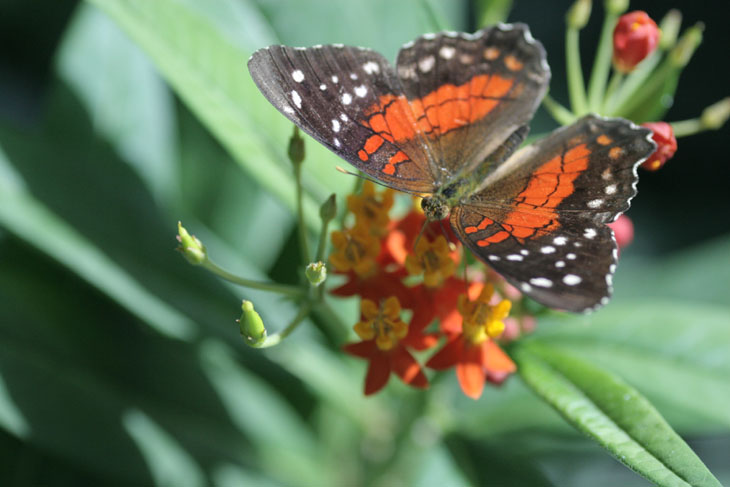
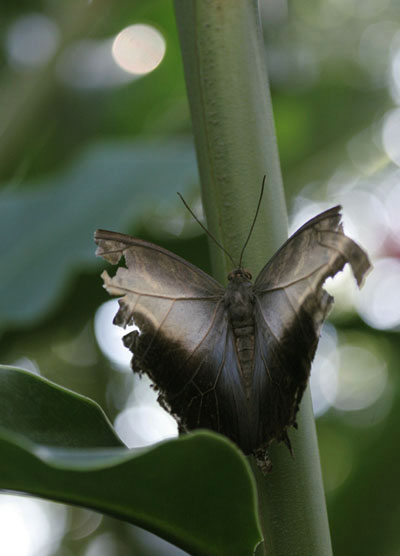 Normally I avoid the butterflies that look tattered or a little beat-up, but this one worked well with the diffuse backlighting, and the color pattern lent it an air of being quite old. It could actually have been, but “quite old” for a butterfly might be a month, and in any case this was the typical coloration of the species, an owl butterfly (Caligo memnon.)
Normally I avoid the butterflies that look tattered or a little beat-up, but this one worked well with the diffuse backlighting, and the color pattern lent it an air of being quite old. It could actually have been, but “quite old” for a butterfly might be a month, and in any case this was the typical coloration of the species, an owl butterfly (Caligo memnon.)
 While it is tempting to think that captive subjects are easy to photograph, this isn’t always the case, especially when it comes to species like this walking leaf insect, of the family Phylliidae. Sure, they’re right there behind the glass (and you’re gonna like them, ’cause they’ve got class!) and certainly not leaping around, but there are reflections from the glass to consider, and distortion if you’re not aiming perpendicular to the glass surface – angles are a no-no. And then there’s the setting, which is often not something useful in any way – in this case, a few plants that served as food and clinging surfaces, backed by the other side of the terrarium (so more glass for reflections) and then the greater environs of the museum, which on a crowded day means constantly moving people in a wide variety of clothes. Thus, it was even easier to get something in the image that was unwanted, in one way or another – which explains this tight closeup. The arthropod itself was probably just shy of the length of your hand, much easier to do detail shots of instead of something a few millimeters long, but backing off for a full body image meant something unwanted was going to be in the frame. Plus, I had to get enough attention on that peculiar head; there are quite a few insects that just seem to have cool looks, for want of a better term, like the orchid mantises (repeat link,) but this is not one of them.
While it is tempting to think that captive subjects are easy to photograph, this isn’t always the case, especially when it comes to species like this walking leaf insect, of the family Phylliidae. Sure, they’re right there behind the glass (and you’re gonna like them, ’cause they’ve got class!) and certainly not leaping around, but there are reflections from the glass to consider, and distortion if you’re not aiming perpendicular to the glass surface – angles are a no-no. And then there’s the setting, which is often not something useful in any way – in this case, a few plants that served as food and clinging surfaces, backed by the other side of the terrarium (so more glass for reflections) and then the greater environs of the museum, which on a crowded day means constantly moving people in a wide variety of clothes. Thus, it was even easier to get something in the image that was unwanted, in one way or another – which explains this tight closeup. The arthropod itself was probably just shy of the length of your hand, much easier to do detail shots of instead of something a few millimeters long, but backing off for a full body image meant something unwanted was going to be in the frame. Plus, I had to get enough attention on that peculiar head; there are quite a few insects that just seem to have cool looks, for want of a better term, like the orchid mantises (repeat link,) but this is not one of them. Another example is this red wolf (Canis rufus,) a Carolina native that was almost decimated due to greater human populations, now being reintroduced through breeding programs. A lot of people decry captive animals of any sort, and I can see their points, but there are a lot of factors that should be taken into consideration that often aren’t – in my experience, people with the firmest opinions usually have the most superficial understandings. Species such as this are being released back into coastal areas, which often sparks protests from farmers and hyperparanoid parents, but the truth of the matter is, the damage they can do is infinitesimal, much less than disease, and they are hardly as aggressive as popular opinion often portrays. The ability to see them in person, as mellow and pleasant as any family dog (more so than a lot, actually,) helps dispel the negative impressions, putting the programs in a more-acceptable frame of reference.
Another example is this red wolf (Canis rufus,) a Carolina native that was almost decimated due to greater human populations, now being reintroduced through breeding programs. A lot of people decry captive animals of any sort, and I can see their points, but there are a lot of factors that should be taken into consideration that often aren’t – in my experience, people with the firmest opinions usually have the most superficial understandings. Species such as this are being released back into coastal areas, which often sparks protests from farmers and hyperparanoid parents, but the truth of the matter is, the damage they can do is infinitesimal, much less than disease, and they are hardly as aggressive as popular opinion often portrays. The ability to see them in person, as mellow and pleasant as any family dog (more so than a lot, actually,) helps dispel the negative impressions, putting the programs in a more-acceptable frame of reference. There are a lot of species of lemur, but the ring-tailed (Lemur catta) is the one that gets 99% of the attention somehow, and I’m actually a little tired of them myself. The ones outdoors were a little active in the chilly air, but not terribly so, and my shooting angle was downwards, which I hate. A cluster of them, however, were in the glassed viewing enclosure, huddled together on a branch a short distance overhead, and I decided to go in close for a portrait, if I could get past the shortcomings of the filthy glass, the bad light, and the inappropriate background. This was the first frame I took, and I was sure I’d gotten reflections in it, so I shot a bunch more, including some great eye-contact and backing off a bit to do a pair. As I unloaded the images and started reviewing them, however, the expression in this one grabbed me immediately, and there was nothing distracting in the frame at all – even the light color is pleasantly warm (note the orangish cast on the cheeks.) It wasn’t my intention at the time, but this is also exactly what you’d want for a magazine cover: simple and direct subject, open space at top for header, and plenty of useful space along sides and bottom for content teasers and barcode. I just like the expectant, Les Mis appeal to the expression, though.
There are a lot of species of lemur, but the ring-tailed (Lemur catta) is the one that gets 99% of the attention somehow, and I’m actually a little tired of them myself. The ones outdoors were a little active in the chilly air, but not terribly so, and my shooting angle was downwards, which I hate. A cluster of them, however, were in the glassed viewing enclosure, huddled together on a branch a short distance overhead, and I decided to go in close for a portrait, if I could get past the shortcomings of the filthy glass, the bad light, and the inappropriate background. This was the first frame I took, and I was sure I’d gotten reflections in it, so I shot a bunch more, including some great eye-contact and backing off a bit to do a pair. As I unloaded the images and started reviewing them, however, the expression in this one grabbed me immediately, and there was nothing distracting in the frame at all – even the light color is pleasantly warm (note the orangish cast on the cheeks.) It wasn’t my intention at the time, but this is also exactly what you’d want for a magazine cover: simple and direct subject, open space at top for header, and plenty of useful space along sides and bottom for content teasers and barcode. I just like the expectant, Les Mis appeal to the expression, though.



















































 That was terrible, I admit it…
That was terrible, I admit it… While I was out, I tried a few other long exposures for giggles, and kinda liked this one. That’s my own shadow across the water there, and I’m amazed at how clear the reflection of the opposite shore is – I don’t think I’ve ever done a long water exposure that sharp. Also, I was apparently accompanied by four ghosts while out there, as you might see when looking at the bottom portion of my shadow. They’re remarkably distinct at full resolution too, but not otherwise mystical – they’re just optical reflections within the lens of the bright lights at top right.
While I was out, I tried a few other long exposures for giggles, and kinda liked this one. That’s my own shadow across the water there, and I’m amazed at how clear the reflection of the opposite shore is – I don’t think I’ve ever done a long water exposure that sharp. Also, I was apparently accompanied by four ghosts while out there, as you might see when looking at the bottom portion of my shadow. They’re remarkably distinct at full resolution too, but not otherwise mystical – they’re just optical reflections within the lens of the bright lights at top right.
 And this is a rather sad cotton pod – usually they burst wide open like popcorn. This is a stacked image, two sandwiched together; one image had the front surface of the husks in focus, the other had the stem and icicle. Shooting handheld in dim light, I didn’t even try for a depth-of-field that would have both of them in focus, because the shutter speed would have gone too slow, so I simply cheated and edited them together afterward. I find this a little too direct and centered for my tastes, but there really weren’t many other framing options – I cut out a lot of distracting elements as it were, and liked the visual aspect of the pod, so there it is.
And this is a rather sad cotton pod – usually they burst wide open like popcorn. This is a stacked image, two sandwiched together; one image had the front surface of the husks in focus, the other had the stem and icicle. Shooting handheld in dim light, I didn’t even try for a depth-of-field that would have both of them in focus, because the shutter speed would have gone too slow, so I simply cheated and edited them together afterward. I find this a little too direct and centered for my tastes, but there really weren’t many other framing options – I cut out a lot of distracting elements as it were, and liked the visual aspect of the pod, so there it is.
 And finally, my favorite image from this short session. I had already walked past these small flowers earlier without noticing them, but had returned to check out another species of plant I’d photographed on an earlier trip, and the tiny splash of color caught my eye this time around. No idea what they are, but the minuscule frozen mist drops were catching the sparse light just well enough to really stand out. And this is probably an ancient holdover from my youth, when grape was my favorite flavor of anything, but that purple color is so compelling I can almost taste it, contrasting nicely with the green as well. It also helps illustrate how low-contrast light can be useful when dealing with a high-contrast or colorful subject – bright sunlight might have been too much.
And finally, my favorite image from this short session. I had already walked past these small flowers earlier without noticing them, but had returned to check out another species of plant I’d photographed on an earlier trip, and the tiny splash of color caught my eye this time around. No idea what they are, but the minuscule frozen mist drops were catching the sparse light just well enough to really stand out. And this is probably an ancient holdover from my youth, when grape was my favorite flavor of anything, but that purple color is so compelling I can almost taste it, contrasting nicely with the green as well. It also helps illustrate how low-contrast light can be useful when dealing with a high-contrast or colorful subject – bright sunlight might have been too much.
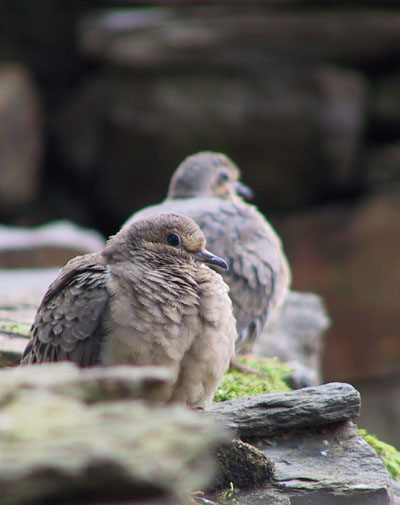 Best rule to follow, but feel free to break as required for results: when the light is high-contrast (very bright with distinct shadows,) look for low-contrast subjects; this is a good time to find those textures, but not things with a lot of detail, especially not a lot of shadows (like foliage.) When the light is low-contrast (light to full overcast,) seek the subjects with high-contrast: lots of different colors, the finely-detailed things that throw a lot of shadows, the clash of textures and colors of the forest floor. Also note that, on bright days, you can find these conditions in shade, whether open shade like under a lone tree or on the shady side of a building, to deep shade like a thick forest canopy.
Best rule to follow, but feel free to break as required for results: when the light is high-contrast (very bright with distinct shadows,) look for low-contrast subjects; this is a good time to find those textures, but not things with a lot of detail, especially not a lot of shadows (like foliage.) When the light is low-contrast (light to full overcast,) seek the subjects with high-contrast: lots of different colors, the finely-detailed things that throw a lot of shadows, the clash of textures and colors of the forest floor. Also note that, on bright days, you can find these conditions in shade, whether open shade like under a lone tree or on the shady side of a building, to deep shade like a thick forest canopy. And that brings us to mood. The color register of the image can do a lot to provoke a particular mood, but you can also do this with elements and setting. The first thing to recognize is how much our moods are affected by weather in the first place, so it’s not hard at all to compose something evocative. Perhaps, when the light is somber and dismal, you find the subject that matches this, like the abandoned house or overgrown woods. Or maybe you’d prefer the anachronism instead, heavy rain on the bright colors of the amusement park rides, icicles on the lifeguard’s chair – tell me these don’t have a story all their own. Some subjects can do well in any kind of weather, such as old cemeteries – this is the time you start noticing the things you might normally have passed by. Fog is such a wonderful thing to work with, not just for the mood itself, but because it can soften or mask distracting elements, heightening isolation, and fog at night is fantastically fun, especially with a well-chosen light source to shine through it.
And that brings us to mood. The color register of the image can do a lot to provoke a particular mood, but you can also do this with elements and setting. The first thing to recognize is how much our moods are affected by weather in the first place, so it’s not hard at all to compose something evocative. Perhaps, when the light is somber and dismal, you find the subject that matches this, like the abandoned house or overgrown woods. Or maybe you’d prefer the anachronism instead, heavy rain on the bright colors of the amusement park rides, icicles on the lifeguard’s chair – tell me these don’t have a story all their own. Some subjects can do well in any kind of weather, such as old cemeteries – this is the time you start noticing the things you might normally have passed by. Fog is such a wonderful thing to work with, not just for the mood itself, but because it can soften or mask distracting elements, heightening isolation, and fog at night is fantastically fun, especially with a well-chosen light source to shine through it. One of the handier things about concentrating on the smaller, individual elements is that you don’t have to go far to use them, or find an appropriate, photogenic subject like an old house; they can be shot right out your back door. But there’s another type of element that is also useful, and that’s the kind that communicates what the weather is like. The fluffed bird that tells you it’s cold, the bent trees or white-capped waves that speak of the wind, the scarf or upturned collar, the diagonal streaks of rain. Since photography is a visual medium, finding the visual elements that convey to the viewer the non-visual aspects is always a plus – make them hear the wind, feel the chill, taste the rain. Give them everything you can to make them feel like they’re right inside it.
One of the handier things about concentrating on the smaller, individual elements is that you don’t have to go far to use them, or find an appropriate, photogenic subject like an old house; they can be shot right out your back door. But there’s another type of element that is also useful, and that’s the kind that communicates what the weather is like. The fluffed bird that tells you it’s cold, the bent trees or white-capped waves that speak of the wind, the scarf or upturned collar, the diagonal streaks of rain. Since photography is a visual medium, finding the visual elements that convey to the viewer the non-visual aspects is always a plus – make them hear the wind, feel the chill, taste the rain. Give them everything you can to make them feel like they’re right inside it.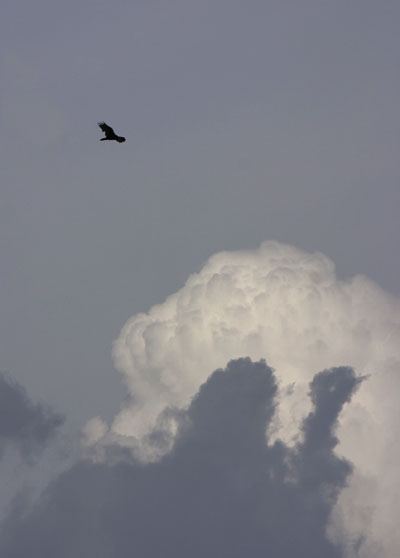 A note about getting cloud detail. Even in heavy overcast, the clouds will probably be a lot brighter than any terrestrial subject, so quite often you have to decide which one you’re going to get an exposure of, since you won’t get both in the same shot (unless you want to mess with
A note about getting cloud detail. Even in heavy overcast, the clouds will probably be a lot brighter than any terrestrial subject, so quite often you have to decide which one you’re going to get an exposure of, since you won’t get both in the same shot (unless you want to mess with 

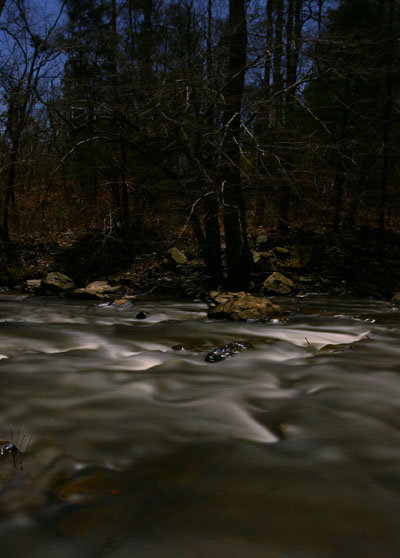 It’s funny how long it took me to get these, since you’d think I’d have the opportunity every full moon. But this also requires clear weather on those nights, a temperature comfortable enough for me to want to be out standing around waiting on the long exposure times, and both a sleep schedule and the desire to go out at midnight or so – these just hadn’t come together previously. If I remember right, a couple of previous occasions had been postponed because I had no readily-available headlamp, which has been rectified now – in fact, I got to try out two new lights, one of which a christmas present, and both worked quite well.
It’s funny how long it took me to get these, since you’d think I’d have the opportunity every full moon. But this also requires clear weather on those nights, a temperature comfortable enough for me to want to be out standing around waiting on the long exposure times, and both a sleep schedule and the desire to go out at midnight or so – these just hadn’t come together previously. If I remember right, a couple of previous occasions had been postponed because I had no readily-available headlamp, which has been rectified now – in fact, I got to try out two new lights, one of which a christmas present, and both worked quite well.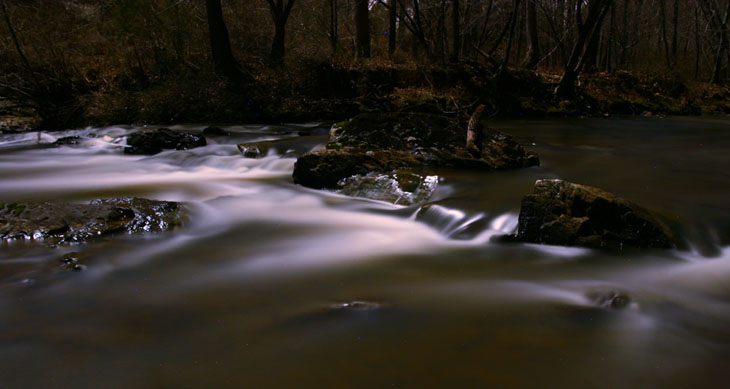

 All of these, with one exception [didn’t I just say, “No text”?], are from this year – the exception is the first one above, since I didn’t have any sunrise shots for the gallery and haven’t gotten any in a while. That one is, like, eleven years old or so, from Florida. Most of the rest are plants, because that’s where I find the colors.
All of these, with one exception [didn’t I just say, “No text”?], are from this year – the exception is the first one above, since I didn’t have any sunrise shots for the gallery and haven’t gotten any in a while. That one is, like, eleven years old or so, from Florida. Most of the rest are plants, because that’s where I find the colors.





